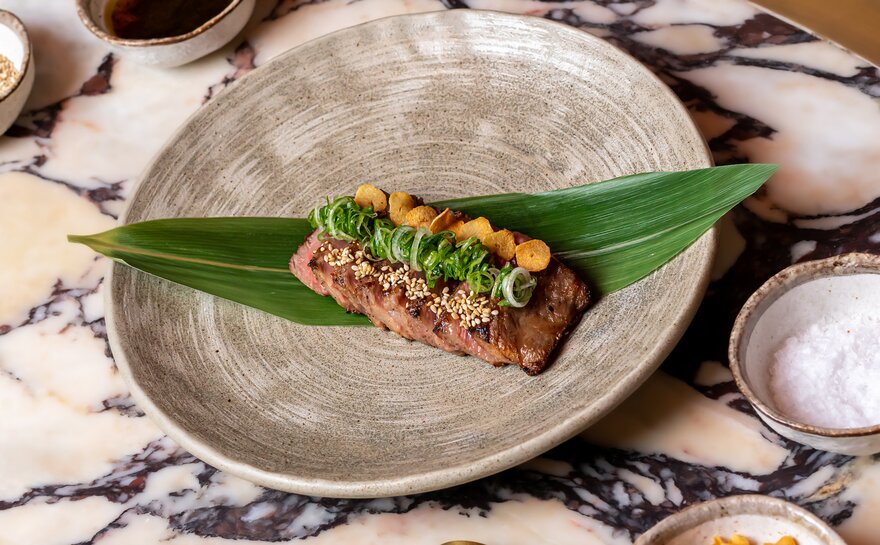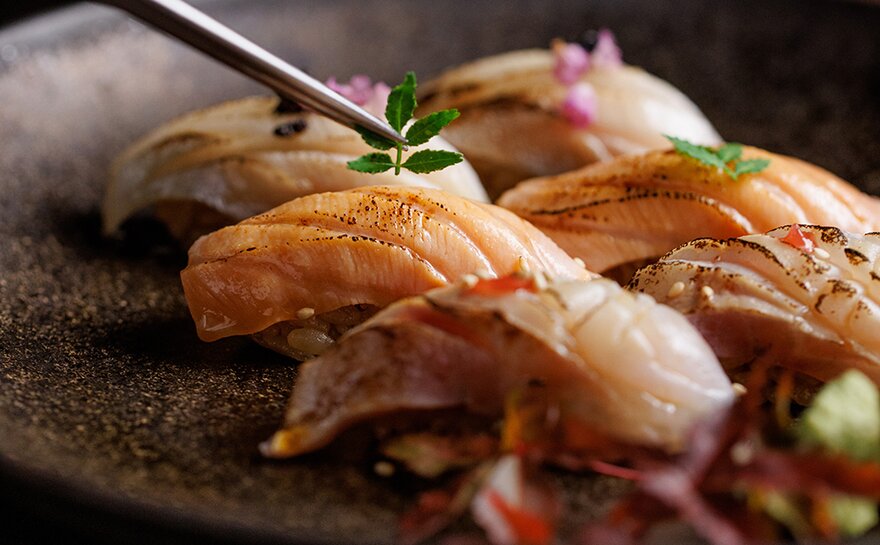London's only female sushi master is demonstrating her considerable skills at the Aubrey at the Mandarin Oriental Hyde Park, London. She speaks about tough training and mastering her craft
Talk me through the training you had to do to become an itamae or head sushi chef
True training really comes through experience. In Japanese cooking, seasonality of ingredients, impeccable presentation and taste are valued above all else. I have been learning for many, many years and developed my skills from working with a huge variety of ingredients and cooking methods. Along with my obsessive reading, I have been able to absorb most of my knowledge from the countless days and nights spent in the kitchen with masters of the craft.
What attracted you to becoming a sushi master?
Details, details, details. There are so many processes in just one small nigiri. Each nigiri reflects my personality, created as I have developed a love for certain ingredients or learned new skills.
The hospitality industry in general is a male-dominated space – especially in the world of chefs – but as the single female sushi master in London, why do you think this is the case? Historically, restaurant kitchens have been male-dominated and I have found that this takes time to change. A lot of sacrifices must be made by a female chef to elevate their skills to the level of top male chefs. It's a choice but one I was happy to make. I'm happy to say that diversity within the industry has certainly progressed outside of the Japan of my youth, especially in London.
Was there a point in your training when you were dissuaded from pursuing the role of itamae?
Yes, of course, but then I changed the way I was thinking. It happened when I didn't have any mentors around to learn from. I had to learn to use each of my senses to create the best food I possibly could. I fell in love with the craft all over again, and I believe this is what I was born to do.
How do you hope to inspire the next generation of female chefs to master the art of sushi?
Believe in yourself and learn that you will be able to do it tomorrow. I truly feel that I am only in the middle of my learning. Time is your greatest gift.
What sacrifices have you made to become an expert in your field?
For me, it is most important to highlight the most base, purest and delicate tastes of the natural ingredients we use in our dishes. I try to keep my palate as clean as possible by avoiding fizzy drinks, smoking and spicy foods to ensure I can discern all the subtleties in our delicate sashimi dishes. Flavours should complement each other when used correctly, but if done badly, the original flavours can be lost.
What bought you to London?
Food! I graduated from a professional cooking college in Japan after getting a national cooking licence. A guest of the restaurant I was working at in Japan offered me a role as sushi chef at JFC Daitokai restaurant in Cologne in Germany, but it was a restaurant called Masturi that brought me to London. After Masturi I worked at Sushi Hana, Oblix at the Shard and at Annabel's in Mayfair before joining the Aubrey.
How are you finding your role at the Aubrey?
Fascinating. My sustainability principles are very similar to that of the Mandarin Oriental and Maximal Concepts [the restaurant group that owns the Aubrey]. We don't serve endangered species of fish and work with seasonal ingredients for this reason, so this means I have to be more creative when designing new dishes. Both companies are respected around the world and so working here is a privilege. I have found the hotel does many things in the hospitality industry in a very considered and professional way – I like this very much.
How many chefs are in your kitchen?
We have 24 chefs in the kitchen. We are a family – I value every member of the team and I love that they have so much pride in their work at the Aubrey.
Sushi at the Aubrey is prepared in the edomae style – how does that differ to traditional sushi?
Edomae sushi uses a short-grain Japanese rice called koshihikari, which has a very high starch content. Edomae sushi rice is washed multiple times before cooking, resulting in a cleaner, more flavourful rice. Other types of sushi rice are usually only washed once or twice.
Edomae sushi rice is cooked using a special method called sushi-meshi. We cook the rice in a large pot with a small amount of water. The rice is then allowed to cool slightly before we mix in vinegar, sugar and salt. This is considered to be the best way to achieve the perfect texture and flavour for true sushi. It is all about the simplicity of the ingredients and the freshness of the flavours.
Tell me about one of your favourite dishes from the menu?
Snow crab roll with passion fruit. The sweet citrus of the passion fruit isn't usually used in traditional Japanese cuisine, but we're always looking for ways to be unique and creative.
Talk me through how you create your kombu-cured hirame and truffle new-style sashimi
We use hirame, a fish native to the northwestern Pacific Ocean. I know it as the Japanese flatfish, but it's often called ‘bastard halibut' in English. It is wrapped and marinated in Japanese kombu [dried brown kelp] for two hours, which enhances the flavour. After marinating we finely slice the kombu-cured hirame to order, never in advance. We serve the dish on a cold stone plate with fresh chives wrapped in thin hirame slices, along with truffle shavings and freshly squeezed yuzu. We finish with a special dressing – but that is my secret recipe.
Where do you get inspiration from?
From the people I meet and the places I visit. Talking to people from different walks of life sparks conversations and ideas that I never would have developed on my own.
How do you consider the plating of your food and the design of your sushi?
Simple. Unified. Pure. Aesthetically Japanese.
What is your career goal as an itamae?
I always try to think about the impact on the global environment while improving myself. I care very much about sustainable produce; I do not like to just stand by, inactive, and watch the world's resources decline. I want to share my experience and knowledge I have developed to become a top chef, while showing the team how to respect the environment.
Outside of the Aubrey, where is your favourite place to eat sushi or Japanese food in London?
Believe it or not I don't have one. I rarely go back to the same restaurant twice. I love the adventure of going to new restaurants to taste, watch and learn.
Complementary cocktails for sushi
Pietro Rizzo, bar director at the Aubrey, talks through the cocktail menu and how it complement's Sato's menu.
"At the Aubrey we are creating something magical. I am very proud to be working with such an incredible team of passionate and professional people. I love being part of team whose aim it is to break the mould. We may be a partnership with the Mandarin Oriental Hyde Park, but our tenet is to feel like a standalone bar and restaurant (an ‘elevated izakaya') within a classic hotel operation.
"From my viewpoint the food complements the cocktails. Our drinks programme celebrates our heritage and namesake: the artist Aubrey Beardsley. He was the editor of The Yellow Book, a short-lived but hugely influential, illustrated quarterly magazine devoted to aesthetics, literature and art, and we have named our cocktail list after the magazine.
"In our volume of The Yellow Book we wanted to highlight his remarkable collaborations with Oscar Wilde and Edgar Allan Poe. Almost akin to Beardsley's life, the drinks menu is divided into three chapters, from Anglo-European-inspired cocktails to traditional Japanese. I hope the elegance and variety of The Yellow Book is going to surprise our guests with its style and flavours.
"I get my inspiration from always looking at the story first and using elements from real life that inspire me to create a concept. Ingredients and flavours will follow once the identity of the drink is defined. In a way, the stories define the drinks' ingredients and presentation."
The Aubrey's Tokyo Martini by Pietro Rizz
- 50ml of your favourite Japanese gin (we like Roku, but Etsu or Kinobi are both great too)
- 15ml Mancino Sakura cherry blossom vermouth
- 10ml water, ideally filtered. If not, Evian or similar will suffice
Pour the ingredients into a clean glass bottle, with a screw cap. You can recycle any you have lying around – just make sure they are well washed out. Pop into the freezer for a minimum of two hours. Take out, pour and enjoy.
If you are feeling fancy, pop your cocktail glasses in the fridge or freezer and cut a thumb-sized wafer of yuzu peel. If you don't have yuzu, lemon would be delicious too.
Recipe: Yellowtail sashimi with spicy ponzu dressing
Serves 2
- 350g-450g yellowtail (fillet steak cut will suffice)
- 3 spring onions
- Half a bunch of shiso leaves
- 1 red bird's eye chilli
- Spicy ponzu dressing
- 2tbs yuzu juice
- 2tbs lemon juice
- 4tbs gluten-free soy sauce
- Red Tabasco – to taste
Mix all the ingredients together and set to one side.
Green shiso oil
- Half a bunch of shiso leaves
- 5tbs of olive oil (you'll have some left over for future dishes)
- Half a bunch of parsley
Using a pan of nearly boiling, salted water, blanch your shiso leaves and parsley for a few seconds and put them straight into the iced water to cool.
Add the blanched shiso leaves and parsley and the olive oil to a blender and give it a 30-second blast.
Strain the mixture through a fine sieve or cloth into a bowl and you should be left with an emerald green oil.
To make the dish, chill a large, flat, round plate. Carefully slice 8-12 slices of yellowtail, each around 4cm square and not more than 5mm thick. Arrange them around the plate in a sunburst, leaving a hole in the centre.
Fill the hole with a big pinch of finely chopped spring onions and shiso leaves. Neatly pop a pea-sized slice of red bird's eye chilli on the centre of each yellowtail slice.
Finish the dish by pouring the spicy ponzu dressing carefully around the plate, taking care not to dislodge the fish or the red bird's eye pepper pieces.
Add a few droplets of your green shiso oil to add extra layers of colour and flavour.
Continue reading
You need to be a premium member to view this. Subscribe from just 99p per week.
Already subscribed? Log In










